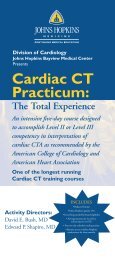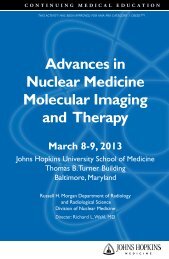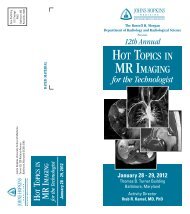View Transcript - Hopkins CME Blog
View Transcript - Hopkins CME Blog
View Transcript - Hopkins CME Blog
Create successful ePaper yourself
Turn your PDF publications into a flip-book with our unique Google optimized e-Paper software.
protein than the milk from the baby’s own mother,<br />
so it has the lowest protein, around 1 gm/dL of<br />
protein or even a little bit less, whereas the mother’s<br />
own milk, at least early on in lactation, has about<br />
1.5 grams per deciliter.<br />
We do know, however, that even the mother’s own<br />
milk, which starts out with more protein than donor<br />
milk has, actually decreases as lactation continues.<br />
So that the mother’s own milk delivering a premature<br />
baby, the protein in that milk declines, and over time<br />
may look more similar to donor or term milk.<br />
Therefore, human milk provided to extremely low<br />
birth weight infants, babies less than a kilogram,<br />
is likely to have inadequate protein content.<br />
In eNeonatal Review, the article reviewed from Sauer<br />
and Kim talks about analyzing human milk with a<br />
spectrophotometer. 4 We also do that here at the<br />
University of Louisville. It allows us to examine in real<br />
time the content of the mother’s milk each day before<br />
it’s provided to the baby. This technology takes about<br />
20 seconds after a human milk sample is provided to<br />
the device and prints out the macronutrient content<br />
of that milk that’s being fed to the baby that day<br />
including the amount of energy. That allows us to<br />
individualize and customize the human milk that that<br />
baby is receiving.<br />
For this particular baby, the 120 ml/kg/day of donor<br />
milk could be providing as little as 1 gm/kg/day to<br />
1.2 gm/kg/day in an infant whose protein<br />
requirement is 4 gm/kg/day. So it is not hard to<br />
understand that this baby is not going to grow very<br />
well. And I believe that we’ll talk more about<br />
fortification in a moment.<br />
MR. BUSKER: Actually, Doctor, let’s take that<br />
moment right now. Tell us more about adjustable<br />
fortification and human milk macronutrient analysis.<br />
DR. ADAMKiN: Sure, thank you. There are two ways to<br />
go about fortifying human milk with a fortifier. One is<br />
an adjustable method. The adjustable method tries to<br />
make up for the changing protein that is decreasing by<br />
analyzing the baby’s BUN as a surrogate for protein<br />
adequacy. So if the BUN is below a certain level — 9<br />
was used in the study that analyzed this strategy —<br />
if the BUN is less than 9, they added more fortifier;<br />
if the BUN was greater than 14, they took away some<br />
fortifier or protein powder.<br />
The method that I alluded to would be called targeted,<br />
or individualized, fortification, where we measure<br />
the protein in the milk, the energy in the milk, and<br />
then we can adjust the nutrient intake based on the<br />
results of the analysis. And again, the paper from<br />
Sauer and Kim in eNeonatal Review showed how to<br />
go about using the point of care spectrophotometry<br />
in the nursery. 4<br />
MR. BUSKER: Thank you for that explanation,<br />
Doctor, and for presenting today’s case discussion.<br />
I want to switch gears now and ask you to look into<br />
the future for us. What upcoming advances do you<br />
see regarding nutritional support for these very low<br />
birth weight infants?<br />
DR. ADAMKiN: I think there is going to be a lot of<br />
excitement about the relationship between nutrition<br />
provided to these very low birth weight babies and<br />
their cognitive outcomes and their risk of adult<br />
diseases later on in life. The so-called programming<br />
of disease that may occur early in life and express<br />
itself later.<br />
The things that I’m referring to for our tiny babies is<br />
methodologies to look at body composition of these<br />
babies. To look at whether or not our feedings are<br />
making them fat or lean. We know that body<br />
composition of these babies may be associated with<br />
the risk later on in life of cardiometabolic diseases.<br />
Another technology that may become available to<br />
use at the bedside in a standard fashion would be<br />
measuring energy expenditure: how are the babies<br />
using the nutrients that we’re giving them, how many<br />
calories are they burning, can we tailor their nutrition<br />
more for the individual baby than simply feeding all of<br />
these babies the same amount of fuel and seeing how<br />
they do. I think measuring body composition and<br />
learning more about their energy expenditure will be<br />
part of the future in optimizing management and<br />
outcomes of these babies.<br />
MR. BUSKER: Thank you for sharing those thoughts,<br />
doctor. To wrap things up, let’s review the key points<br />
of today’s discussion in light of our learning<br />
objectives. So to begin: the importance of starting<br />
parenteral nutrition in the first hours of life in very<br />
low birth weight infants, even in the face of critical<br />
illness.<br />
eNeonatal Review Podcast <strong>Transcript</strong>, Volume 9: Issue 14<br />
5
















